Wireframes
This is a collection of wire-frames I have constructed. I used these wire frames to generate images on my computer (CGI). I've also included an images of models that where used for a cover for the Black Library novel (Warhammer 40,000). 3D work is a lot of fun, and I wish I made the time to fit more in, but alas life is too busy. I suppose the mark of any good 3D modeller is the ability to construct a head with the core tool set, this is my attempt;
Head sculpt wire-frame
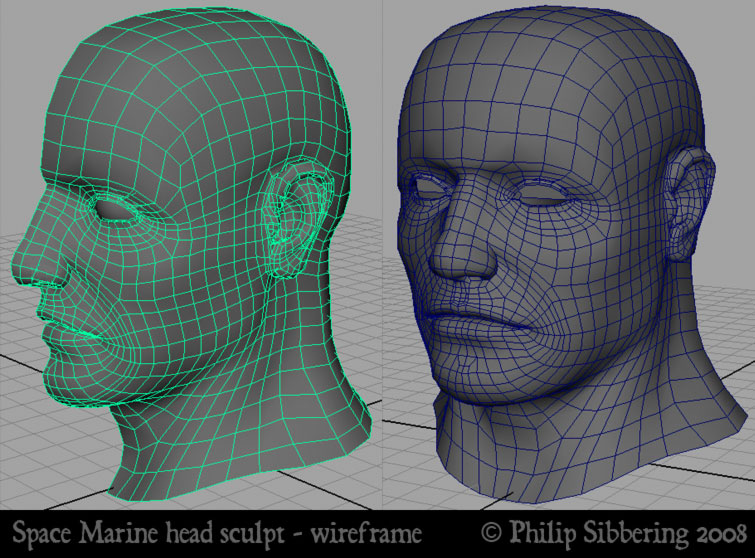
This was a lot of fun to sculpt, especially the complex shapes like the eyes, nose and ears. There were not crafted in a sculpting program like mudbox or zbrush. Instead I crafted these by pushing vertexes about, and cutting polygons - just to see if I could: and it turns out I could! The ear wire-frame is interesting as a piece of sculpture in and of itself - I wanted to keep it all quads like the rest of the sculpt, and in turned into a bit of a 3D puzzle. It does have some triangles in it, but it wouldn't take much to make it all quads (and port it over to something like zbrush to subdivide). It's not perfect, but not bad for my first attempt (first attempt at sculpting a head - not using the program!)
Head sculpt matt render
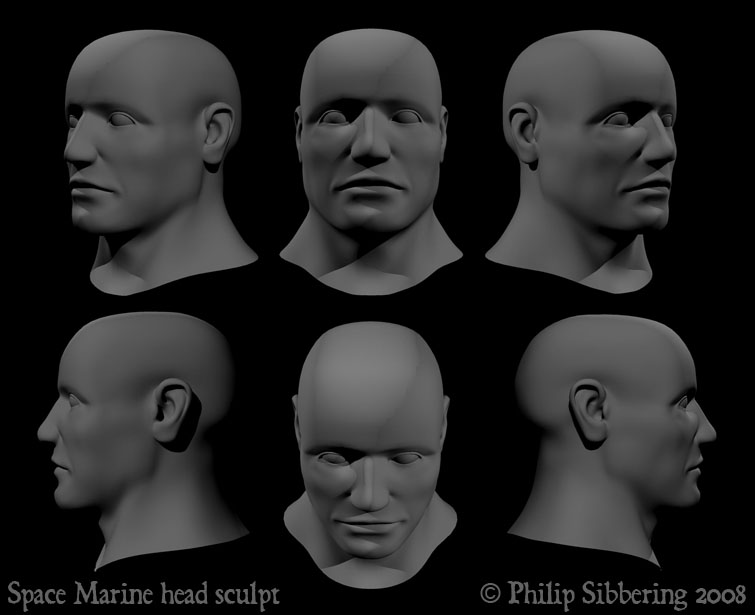
This is a matt render of the finished sculpt and shows of the actual shapes of the face. I wanted a strong face borrowing characteristics from several population clines. In the end I think he looks a bit Dutch? Maybe I'm half remembering a painting from somewhere?
Warrior Coven - Muscle rig
This is the wire frame and muscle rig for the cover of Warrior Coven. The muscle rig is used to influence deformation of the model's mesh. In the hopes that arms and legs, when posed, bend less like rubber tubes, and more like real limbs of bone and muscle. One way to do this is with morph targets, which is re-sculpting the model in a new pose and having the software work out the morphs in between. The only problem with a complex model like a humans is the number of morphs needed (usually this is used for the face!). Another way to do this, as shown here, is to build a skeleton, add muscles than deform realistically (they have their own morphs, but as they are a tube it is easy to work out) and then use that to push the model's mesh as if it was a skin. The can get very complex, but there is software plugins to speed up the process.
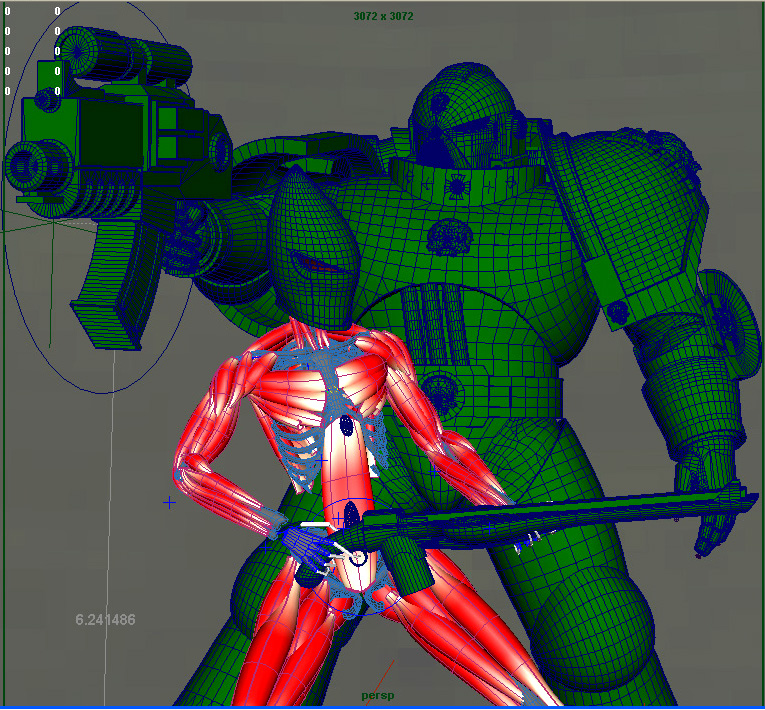
Some areas to note on the Eldar model is the elbow, as the muscle structure can be seen to fill in the hollow of the arm and the elbow and flesh is quite thick when the arm is bent, another is the twist is the shoulder and how it maintains it's volume. In model terms all the 'muscles' retain their volume as if filled with matter, and not bend as if empty rubber tubes (as basic 3D skinning tends to do).
Comic book
Carrying on from the above 3D section above, one of the main drives behind my creating 3D models is to use them more than once. A 3D model is a huge investment in time, and only really pays off it they are used again and again (just like in a movie). I don't have the budget of hardware to create a movie but I thought the next best thing was to create a comic. This would reuse the characters to render the images and help maintain quality throughout the comic to the very end, even in a massive epic, the last page would be a perfect as the first. The models could be added in as the comic progresses and new characters made and introduced. Each character could be distinct and worked up, and their model changed as events impact the characters. One idea that I though would be fun was to work out how Marine armour actually works and then have it damage to reveal the inner workings.
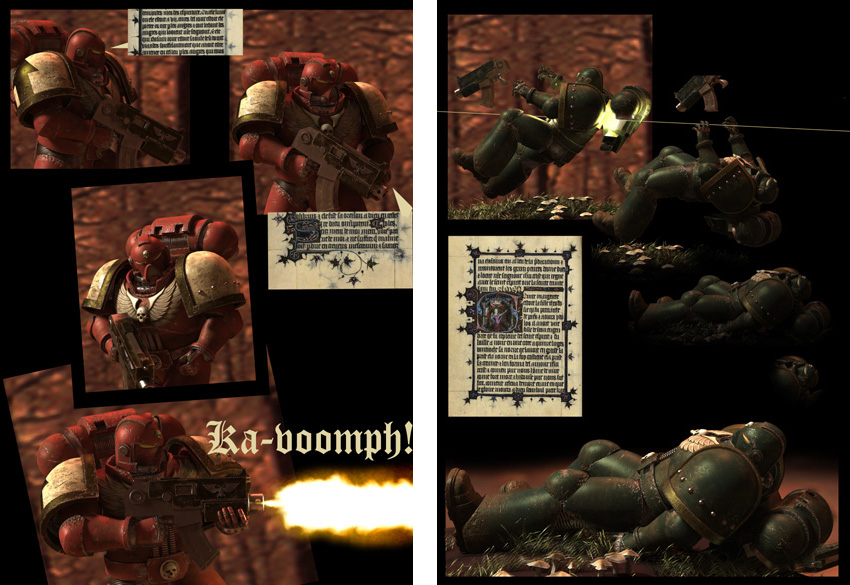
Tester
I put together a quick tester to see how it would render and work out. The models used are not actual purpose built characters, the loyalist Marine is a Blood Raven model for the Dawn of War cover: Tempest, and the green Marine is nothing more than a colour swap on the armour.
The thought was the idea of the 'Covenet' alerting the Marine to an enemy, however in an actual story this little event world not actually happen as the bolt would not go through the target. The mode 1 bolt explosion may take a Marine off their feet, but the bolt would be easily defeated by the advanced Marine armour (electric-armour defeats RPGs). In the reality of (Philhammer) 40K this Marine would still get up, but would have suffered far less damage. The only way the above could work is if the electric-armour component of the power-armour had malfunctioned (possible if a chaos Marine) or was turned off (never).
In designing for a comic (or movie) there is far less leeway to fudge the armour design of the Marine (or else you will be constantly correcting the armour which kind defeats the whole speed advantage of using 3D software) and so a lot more thought has to be paid to how the Marine armour actually works. I am tempted to completely redesign the armour and further develop my ideas on the mechanics and engineering of the 'power' armour. In doing this I would like to show how specifics of power armour design such as how the shoulder array's inner motivated spaulder array and floating outer pauldron function, and cover design element like motivated plates over the front of the elbow joint and the back of the knee joint to stop weakness. Even the ablative insert system, and electric-armour diagrams - all fun stuff like that! What's not to like about cut away diagrams and thick books on Ad-Mec armour theory? (if only there was more time in a day).
Epics
Another area where the time investment in creating a 3D model pays off is in duplication, such as the cover of False Gods (originally it was for Horus Rising). There are hundreds of marines in this image. I wanted a more 'classical' lighting in this piece, and to maintain a good flow, as the marines surge forward.
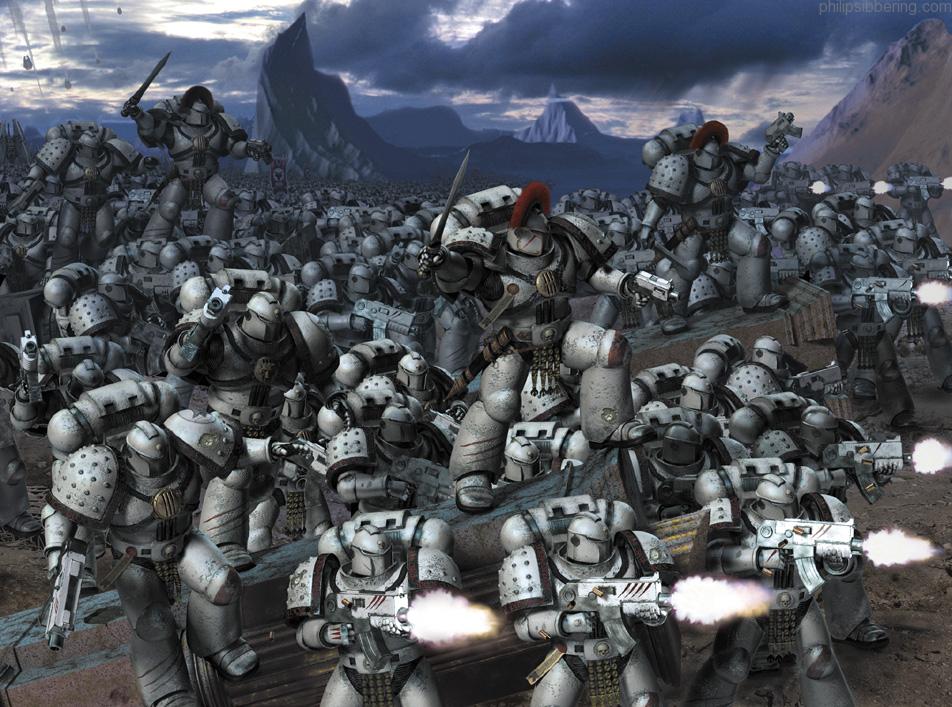
Connect
If you liked this, and would like to leave a comment on my guestbook, or catch up on all the recent comments, please visit my connect page. While there, you can also subscribe to email notifications, so you never miss a new post, along with my RSS feed as a backup. If you are feeling generous, and I know times are hard, you may support my site through Patreon (exclusive behind the scenes content), PayPal or Bitcoin! Lastly, there is a confidential contact form for any secret messages you wish to pass to me. Thank you for reading, and I look forward to hearing what you have to say :)
